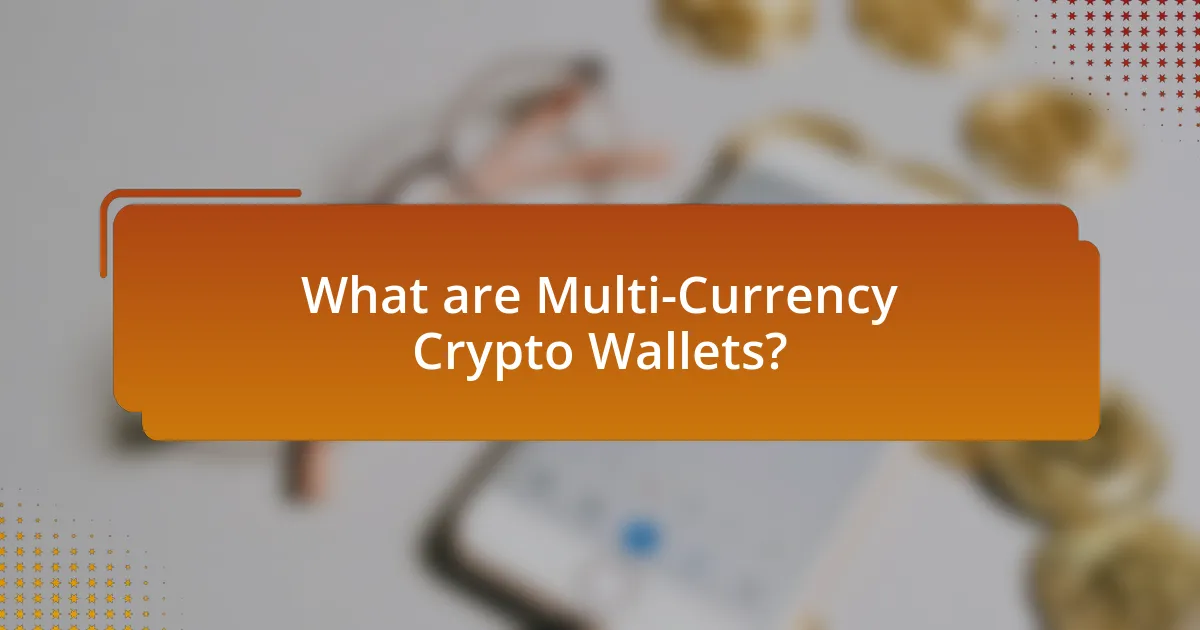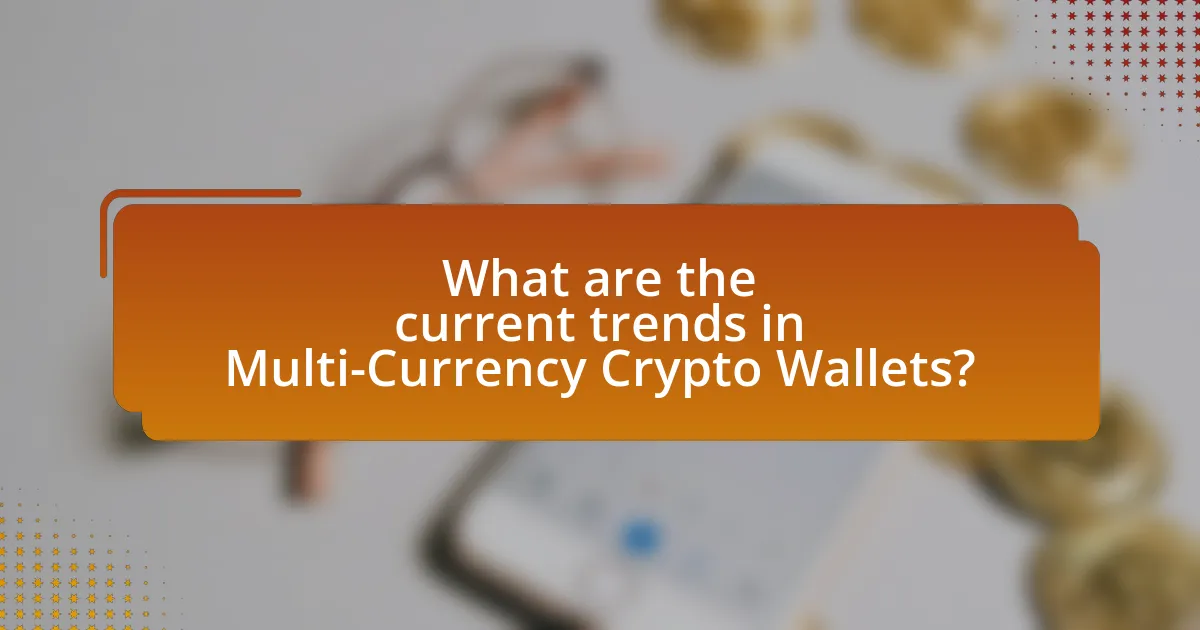Multi-currency crypto wallets are digital platforms that enable users to store, manage, and transact with various cryptocurrencies within a single interface, enhancing convenience and efficiency. This article explores the functionality, underlying technologies, and user interactions associated with these wallets, highlighting their advantages, security features, and the growing demand driven by the diversification of cryptocurrencies. It also examines current trends, regulatory impacts, and future predictions for multi-currency wallets, emphasizing the importance of user preferences and emerging technologies in shaping their development. Key insights include the integration of decentralized finance (DeFi) features and the necessity for robust security measures as the cryptocurrency landscape continues to evolve.

What are Multi-Currency Crypto Wallets?
Multi-currency crypto wallets are digital wallets that allow users to store, manage, and transact with multiple cryptocurrencies within a single interface. These wallets support various cryptocurrencies, enabling users to hold assets like Bitcoin, Ethereum, and Litecoin simultaneously. The functionality of multi-currency wallets enhances user convenience by eliminating the need for separate wallets for each cryptocurrency, thus streamlining the management of diverse digital assets.
How do Multi-Currency Crypto Wallets function?
Multi-currency crypto wallets function by allowing users to store, manage, and transact with multiple cryptocurrencies within a single interface. These wallets utilize a combination of public and private keys to facilitate transactions across various blockchain networks, enabling seamless exchanges between different digital assets. For instance, a multi-currency wallet can support Bitcoin, Ethereum, and Litecoin, allowing users to send and receive these currencies without needing separate wallets for each. This functionality is made possible through integrated software that interacts with multiple blockchain protocols, ensuring that users can easily access and manage their diverse cryptocurrency holdings in one place.
What technologies underpin Multi-Currency Crypto Wallets?
Multi-currency crypto wallets are primarily underpinned by blockchain technology, cryptographic algorithms, and secure key management systems. Blockchain technology enables the decentralized storage and transaction of multiple cryptocurrencies, ensuring transparency and security. Cryptographic algorithms, such as SHA-256 and ECDSA, provide the necessary security for transaction verification and wallet access. Additionally, secure key management systems, including hardware security modules and multi-signature protocols, enhance the protection of private keys, which are essential for accessing and managing various cryptocurrencies. These technologies collectively ensure that multi-currency crypto wallets operate efficiently and securely in a diverse digital currency ecosystem.
How do users interact with Multi-Currency Crypto Wallets?
Users interact with Multi-Currency Crypto Wallets by managing multiple cryptocurrencies within a single platform, allowing for seamless transactions, storage, and conversion. This interaction typically involves creating an account, linking bank accounts or credit cards, and transferring various cryptocurrencies into the wallet. Users can then send, receive, and exchange different currencies, often utilizing built-in features for real-time market data and transaction history. According to a report by Statista, the global cryptocurrency wallet market is projected to grow significantly, indicating increasing user engagement and reliance on these wallets for diverse crypto management.
What advantages do Multi-Currency Crypto Wallets provide?
Multi-currency crypto wallets provide the advantage of allowing users to store, manage, and transact with multiple cryptocurrencies in a single platform. This convenience reduces the need for multiple wallets, streamlining the user experience and enhancing accessibility. Additionally, multi-currency wallets often support a wide range of digital assets, enabling users to diversify their portfolios easily. According to a report by Statista, the number of cryptocurrencies has grown significantly, exceeding 10,000 in 2021, highlighting the necessity for wallets that can accommodate various assets. Furthermore, these wallets typically offer features such as real-time exchange rates and integrated trading options, which facilitate seamless transactions and better financial management for users.
How do Multi-Currency Crypto Wallets enhance user convenience?
Multi-currency crypto wallets enhance user convenience by allowing individuals to store, manage, and transact with multiple cryptocurrencies in a single platform. This integration simplifies the user experience, as it eliminates the need for multiple wallets, reducing the complexity of managing different assets. According to a report by Statista, the number of cryptocurrencies has grown significantly, exceeding 10,000 in 2021, which underscores the necessity for a streamlined solution. Additionally, multi-currency wallets often provide real-time exchange rates and seamless conversions between currencies, further facilitating transactions and investment strategies. This capability not only saves time but also minimizes transaction fees associated with transferring assets between different wallets.
What security features are essential in Multi-Currency Crypto Wallets?
Essential security features in multi-currency crypto wallets include two-factor authentication (2FA), encryption, and backup recovery options. Two-factor authentication adds an extra layer of security by requiring a second form of verification, significantly reducing the risk of unauthorized access. Encryption protects the wallet’s private keys and sensitive data, ensuring that even if the wallet is compromised, the information remains secure. Backup recovery options allow users to restore their wallets in case of loss or theft, safeguarding their assets. These features are critical in protecting users’ investments and maintaining trust in the wallet’s security.
Why is there a growing demand for Multi-Currency Crypto Wallets?
The growing demand for Multi-Currency Crypto Wallets is primarily driven by the increasing diversification of cryptocurrencies and the need for users to manage multiple digital assets efficiently. As the cryptocurrency market expands, with thousands of different coins and tokens available, users require wallets that can support various currencies in one platform, simplifying transactions and enhancing user experience. According to a report by Statista, the number of cryptocurrencies has surged from around 1,000 in 2017 to over 10,000 in 2023, highlighting the necessity for wallets that can accommodate this variety. Additionally, the rise of decentralized finance (DeFi) and cross-border transactions further fuels the need for wallets that can handle multiple currencies seamlessly, allowing users to capitalize on different market opportunities without the hassle of switching between multiple wallets.
What trends are driving the adoption of Multi-Currency Crypto Wallets?
The adoption of Multi-Currency Crypto Wallets is primarily driven by the increasing demand for diversification in cryptocurrency investments. As more investors seek to manage multiple digital assets within a single platform, the convenience and efficiency of multi-currency wallets become essential. Additionally, the rise of decentralized finance (DeFi) platforms has encouraged users to hold various cryptocurrencies to participate in lending, staking, and yield farming opportunities. Furthermore, the growing acceptance of cryptocurrencies by merchants and businesses worldwide necessitates wallets that can handle multiple currencies, enhancing usability and accessibility. According to a report by Statista, the number of cryptocurrency users worldwide reached over 300 million in 2021, highlighting the expanding user base that multi-currency wallets cater to.
How do market dynamics influence the rise of Multi-Currency Crypto Wallets?
Market dynamics significantly influence the rise of Multi-Currency Crypto Wallets by driving demand for diverse cryptocurrency management solutions. As the cryptocurrency market expands, with over 10,000 cryptocurrencies available as of 2023, users increasingly seek wallets that can accommodate multiple currencies to facilitate trading, investment, and transactions across various platforms. This demand is further fueled by the growing acceptance of cryptocurrencies in mainstream finance, evidenced by a 2022 survey indicating that 46% of Americans view cryptocurrencies as a legitimate investment. Additionally, market volatility compels users to diversify their holdings, prompting the need for wallets that support multiple assets. Consequently, the interplay of increasing cryptocurrency adoption, user demand for diversification, and market volatility collectively accelerates the development and adoption of Multi-Currency Crypto Wallets.

What are the current trends in Multi-Currency Crypto Wallets?
Current trends in multi-currency crypto wallets include increased adoption of decentralized finance (DeFi) features, enhanced security measures, and integration with traditional financial systems. The rise of DeFi has led to wallets offering functionalities such as yield farming and staking, allowing users to earn returns on their crypto assets. Enhanced security measures, including biometric authentication and multi-signature capabilities, are being implemented to protect users’ funds amid rising cyber threats. Additionally, the integration of multi-currency wallets with traditional banking services is facilitating easier access to cryptocurrencies for mainstream users, as evidenced by partnerships between crypto wallet providers and banks. These trends reflect the evolving landscape of digital finance and the growing demand for versatile and secure crypto management solutions.
How are user preferences evolving in the crypto wallet market?
User preferences in the crypto wallet market are increasingly shifting towards multi-currency wallets that support a diverse range of cryptocurrencies. This evolution is driven by the growing demand for flexibility and convenience, as users seek wallets that can accommodate various digital assets in one platform. According to a report by Statista, the number of cryptocurrencies has surged to over 10,000, highlighting the necessity for wallets that can manage multiple currencies efficiently. Additionally, user interest in enhanced security features and user-friendly interfaces is rising, as evidenced by a survey from Crypto Wallets Research, which found that 68% of users prioritize security when choosing a wallet.
What features are users prioritizing in Multi-Currency Crypto Wallets?
Users are prioritizing security, user-friendly interfaces, and support for a wide range of cryptocurrencies in Multi-Currency Crypto Wallets. Security features such as two-factor authentication and biometric access are essential, as they protect users’ assets from theft and hacking. A user-friendly interface enhances the overall experience, making it easier for both novice and experienced users to navigate the wallet. Additionally, the ability to store and manage multiple cryptocurrencies is crucial, as it allows users to diversify their portfolios without needing separate wallets for each currency. According to a survey by Statista, 40% of cryptocurrency users consider security the most important feature, while 30% prioritize ease of use, highlighting these preferences among users.
How is the integration of DeFi impacting Multi-Currency Crypto Wallets?
The integration of DeFi is significantly enhancing the functionality and appeal of Multi-Currency Crypto Wallets by enabling users to access decentralized financial services directly within their wallets. This integration allows users to lend, borrow, and earn interest on their crypto assets without the need for intermediaries, thereby increasing the utility of these wallets. For instance, as of 2023, platforms like Aave and Compound have seen substantial growth, with Aave reporting over $5 billion in total value locked, demonstrating the demand for DeFi services. Consequently, Multi-Currency Crypto Wallets are evolving to incorporate features such as yield farming and liquidity provision, making them more attractive to users seeking diverse financial opportunities.
What role do regulatory changes play in the development of Multi-Currency Crypto Wallets?
Regulatory changes significantly influence the development of Multi-Currency Crypto Wallets by establishing the legal framework within which these wallets operate. These regulations can dictate compliance requirements, security standards, and user protections, which in turn affect how wallet providers design their services. For instance, the implementation of the Financial Action Task Force’s Travel Rule in 2019 required crypto service providers to share customer information for transactions, prompting wallet developers to integrate features that ensure compliance. Additionally, countries like the United States and the European Union have introduced regulations that require Know Your Customer (KYC) processes, compelling wallet providers to enhance their identity verification systems. Such regulatory shifts not only shape the operational landscape but also influence user trust and adoption rates, as consumers are more likely to engage with wallets that adhere to recognized legal standards.
How are regulations shaping the features of Multi-Currency Crypto Wallets?
Regulations are significantly shaping the features of Multi-Currency Crypto Wallets by enforcing compliance standards that enhance security, transparency, and user identification. For instance, regulatory bodies like the Financial Action Task Force (FATF) have introduced guidelines requiring wallet providers to implement Know Your Customer (KYC) protocols, which necessitate user verification to prevent fraud and money laundering. This has led to the integration of identity verification features within wallets, ensuring that users are authenticated before transactions can occur. Additionally, regulations are pushing wallet developers to incorporate advanced security measures, such as multi-signature authentication and encryption, to protect user assets and comply with legal requirements. As a result, the evolving regulatory landscape is driving innovation in wallet features, making them more secure and compliant with international standards.
What compliance challenges do Multi-Currency Crypto Wallets face?
Multi-currency crypto wallets face significant compliance challenges primarily due to varying regulatory frameworks across jurisdictions. These wallets must navigate complex anti-money laundering (AML) and know your customer (KYC) requirements, which differ from one country to another. For instance, in the European Union, the Fifth Anti-Money Laundering Directive mandates strict customer verification processes, while in other regions, regulations may be less stringent or even non-existent. Additionally, the decentralized nature of cryptocurrencies complicates the enforcement of these regulations, as transactions can occur without a central authority, making it difficult for regulators to track and monitor activities effectively. This inconsistency in regulatory expectations can lead to legal risks and operational hurdles for wallet providers, who must ensure compliance to avoid penalties and maintain user trust.

What predictions can be made about the future of Multi-Currency Crypto Wallets?
The future of Multi-Currency Crypto Wallets is expected to see significant growth and innovation, driven by increasing adoption of cryptocurrencies and the demand for seamless cross-border transactions. As of 2023, the global cryptocurrency market is projected to reach a valuation of over $2 trillion, indicating a robust interest in digital assets. This trend suggests that multi-currency wallets will become essential tools for users who wish to manage diverse cryptocurrency portfolios efficiently. Furthermore, advancements in security features, such as biometric authentication and decentralized finance (DeFi) integrations, will likely enhance user trust and functionality. The rise of regulatory frameworks around cryptocurrencies will also push wallet providers to comply with standards, leading to more secure and user-friendly options in the market.
How might technological advancements influence Multi-Currency Crypto Wallets?
Technological advancements will significantly enhance Multi-Currency Crypto Wallets by improving security, user experience, and interoperability. Innovations such as biometric authentication and advanced encryption techniques will bolster security, reducing the risk of hacks and unauthorized access. Furthermore, the integration of artificial intelligence can streamline transaction processes and provide personalized financial insights, making wallets more user-friendly. Additionally, advancements in blockchain technology will facilitate seamless exchanges between different cryptocurrencies, enhancing interoperability and allowing users to manage diverse assets more efficiently. For instance, the implementation of layer-2 solutions can increase transaction speeds and reduce costs, making Multi-Currency Crypto Wallets more attractive to users.
What emerging technologies could enhance Multi-Currency Crypto Wallets?
Emerging technologies that could enhance Multi-Currency Crypto Wallets include decentralized finance (DeFi) protocols, artificial intelligence (AI) for transaction optimization, and blockchain interoperability solutions. DeFi protocols enable users to access a wider range of financial services directly from their wallets, increasing functionality and user engagement. AI can analyze transaction patterns to provide personalized recommendations and enhance security measures, thereby improving user experience and safety. Blockchain interoperability solutions, such as Polkadot and Cosmos, allow different blockchain networks to communicate, facilitating seamless transactions across multiple currencies and enhancing the wallet’s usability. These technologies collectively contribute to a more robust, efficient, and user-friendly multi-currency crypto wallet ecosystem.
How will user experience evolve in future Multi-Currency Crypto Wallets?
User experience in future multi-currency crypto wallets will evolve through enhanced user interfaces, improved security features, and seamless integration with decentralized finance (DeFi) applications. These wallets will likely adopt intuitive designs that simplify navigation and transaction processes, making them accessible to a broader audience. For instance, the integration of biometric authentication and advanced encryption methods will bolster security, addressing user concerns about asset safety. Additionally, as DeFi continues to grow, multi-currency wallets will provide users with streamlined access to various financial services, such as lending and staking, all within a single platform. This evolution is supported by the increasing demand for user-friendly solutions in the crypto space, as evidenced by the rise in adoption rates of wallets that prioritize usability and security.
What market trends are likely to shape the future of Multi-Currency Crypto Wallets?
The future of Multi-Currency Crypto Wallets will be shaped by increasing regulatory clarity, enhanced security features, and the growing adoption of decentralized finance (DeFi). Regulatory clarity is essential as governments worldwide are establishing frameworks that will legitimize and standardize cryptocurrency transactions, thereby increasing user trust and adoption. Enhanced security features, such as biometric authentication and multi-signature capabilities, are becoming critical as users seek to protect their assets from cyber threats; a report by Cybersecurity Ventures predicts that cybercrime will cost the world $10.5 trillion annually by 2025, emphasizing the need for robust security measures. Additionally, the rise of DeFi platforms is driving demand for wallets that can support multiple cryptocurrencies and tokens, as users look for seamless access to various financial services. These trends indicate a significant evolution in the functionality and acceptance of Multi-Currency Crypto Wallets in the coming years.
How will competition affect the development of Multi-Currency Crypto Wallets?
Competition will drive innovation and feature enhancement in the development of Multi-Currency Crypto Wallets. As various companies enter the market, they will strive to differentiate their products by offering unique functionalities, improved security measures, and user-friendly interfaces. For instance, the rise of competitors like Exodus and Trust Wallet has led to increased focus on integrating decentralized finance (DeFi) features and supporting a wider range of cryptocurrencies. This competitive landscape encourages continuous improvements, as companies must adapt to consumer demands and technological advancements to maintain market share. Consequently, the overall quality and capabilities of Multi-Currency Crypto Wallets are likely to improve, benefiting users with more robust and versatile options.
What potential partnerships could emerge in the Multi-Currency Crypto Wallet space?
Potential partnerships in the Multi-Currency Crypto Wallet space could include collaborations between wallet providers and financial institutions, payment processors, and blockchain technology firms. For instance, wallet providers may partner with banks to facilitate seamless fiat-to-crypto transactions, enhancing user accessibility. Additionally, partnerships with payment processors like PayPal or Stripe could enable users to transact in multiple currencies directly from their wallets, increasing adoption. Collaborations with blockchain technology firms can also lead to improved security features and interoperability between different cryptocurrencies, which is essential for user trust and functionality. These partnerships are supported by the growing trend of integrating traditional finance with cryptocurrency services, as evidenced by the increasing number of banks exploring digital asset offerings.
What best practices should users follow when choosing a Multi-Currency Crypto Wallet?
When choosing a Multi-Currency Crypto Wallet, users should prioritize security features, such as two-factor authentication and private key control. Security is crucial because it protects users’ assets from theft and hacking, which are prevalent in the cryptocurrency space. Additionally, users should evaluate the wallet’s compatibility with various cryptocurrencies, ensuring it supports the specific coins they intend to store. This compatibility is essential as it allows users to manage multiple assets in one place efficiently. Furthermore, users should consider the wallet’s user interface and ease of use, as a straightforward design can enhance the overall experience, especially for beginners. Lastly, researching the wallet’s reputation and user reviews can provide insights into its reliability and performance, helping users make informed decisions.
How can users assess the security of Multi-Currency Crypto Wallets?
Users can assess the security of Multi-Currency Crypto Wallets by evaluating several key factors, including the wallet’s encryption methods, private key management, and the reputation of the wallet provider. Strong encryption protocols, such as AES-256, ensure that user data is protected from unauthorized access. Additionally, wallets that allow users to control their private keys provide a higher level of security, as this minimizes the risk of third-party access. The reputation of the wallet provider can be gauged through user reviews, security audits, and the history of any security breaches. For instance, wallets with a track record of regular updates and transparent security practices are generally considered more secure.
What features should users look for in a reliable Multi-Currency Crypto Wallet?
Users should look for security, user-friendliness, multi-currency support, and backup options in a reliable Multi-Currency Crypto Wallet. Security features such as two-factor authentication and encryption protect users’ assets from unauthorized access. User-friendliness ensures that both beginners and experienced users can navigate the wallet easily, which is crucial given the complexity of cryptocurrency transactions. Multi-currency support allows users to store various cryptocurrencies in one place, enhancing convenience and flexibility. Backup options are essential for recovering funds in case of device loss or failure, ensuring that users do not lose access to their assets. These features collectively contribute to a trustworthy and efficient multi-currency crypto wallet experience.


